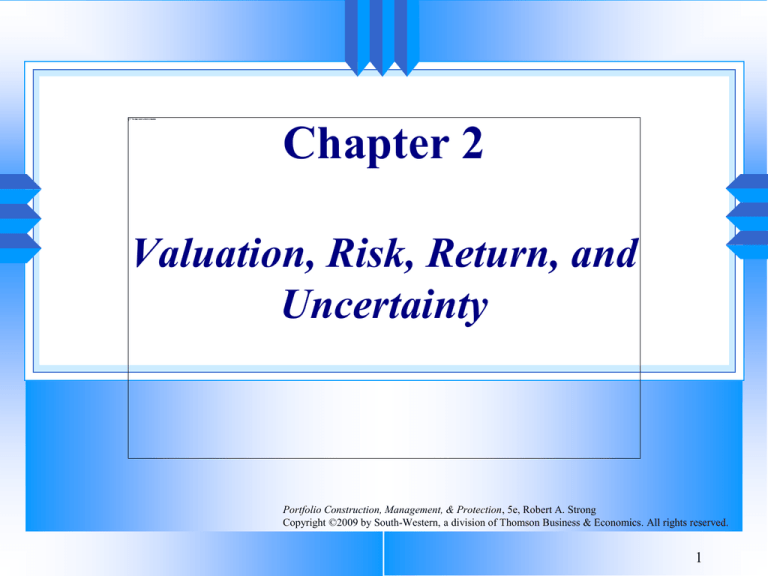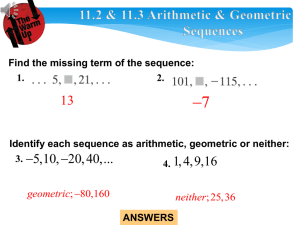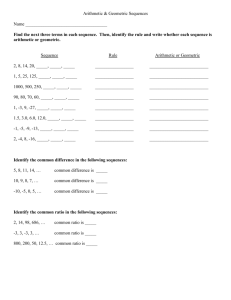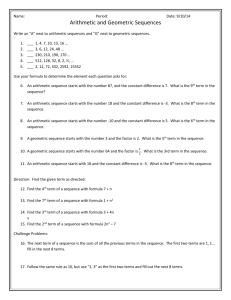
Chapter 2
Valuation, Risk, Return, and
Uncertainty
Portfolio Construction, Management, & Protection, 5e, Robert A. Strong
Copyright ©2009 by South-Western, a division of Thomson Business & Economics. All rights reserved.
1
It’s what we learn after we think we know it
all that counts.
Kin Hubbard
2
Outline
Introduction
Valuation
Safe
Dollars and Risky Dollars
Relationship Between Risk and Return
The Concept of Return
Some Statistical Facts of Life
3
Introduction
The
occasional reading of basic material in
your chosen field is an excellent
philosophical exercise
• Do not be tempted to conclude that you “know
it all”
– e.g., what is the present value of a growing
perpetuity that begins payments in five years?
4
Valuation
Valuation
may be the most important part of
the study of investments
• Security analysts make a career of estimating
“what you get” for “what you pay”
• The time value of money is one of the two key
concepts in finance and is very useful in
valuation
5
Growing Income Streams
A
growing stream is one in which each
successive cash flow is larger than the
previous one
• A common problem is one in which the cash
flows grow by some fixed percentage
6
Growing Annuity
A
growing annuity is an annuity in which
the cash flows grow at a constant rate g:
C
C (1 g ) C (1 g ) 2
C (1 g ) n
PV
...
2
3
(1 R) (1 R)
(1 R)
(1 R) n 1
N
C1
1 g
1
R g 1 R
7
Growing Perpetuity
A
growing perpetuity is an annuity where
the cash flows continue indefinitely:
C
C (1 g ) C (1 g ) 2
C (1 g )
PV
...
2
3
(1 R) (1 R)
(1 R)
(1 R)
Ct (1 g )t 1
C1
t
(1 R)
Rg
t 1
8
Safe Dollars and Risky Dollars
A
safe dollar is worth more than a risky
dollar
• Investing in the stock market is exchanging
bird-in-the-hand safe dollars for a chance at a
higher number of dollars in the future
9
Safe Dollars and
Risky Dollars (cont’d)
Most
investors are risk averse
• People will take a risk only if they expect to be
adequately rewarded for taking it
People
have different degrees of risk
aversion
• Some people are more willing to take a chance
than others
10
Choosing Among
Risky Alternatives
Example
You have won the right to spin a lottery wheel one time.
The wheel contains numbers 1 through 100, and a pointer
selects one number when the wheel stops. The payoff
alternatives are on the next slide.
Which alternative would you choose?
11
Choosing Among
Risky Alternatives (cont’d)
A
[1–50]
[51–100]
Average
payoff
B
$110 [1–50]
$90 [51–100]
$100
Number on lottery wheel appears in brackets.
C
$200 [1–90]
$0 [91–100]
$100
D
$50 [1–99]
$550 [100]
$100
$1,000
–$89,000
$100
12
Choosing Among
Risky Alternatives (cont’d)
Example (cont’d)
Solution:
Most people would think Choice A is “safe.”
Choice B has an opportunity cost of $90 relative
to Choice A.
People who get utility from playing a game pick
Choice C.
People who cannot tolerate the chance of any
loss would avoid Choice D.
13
Choosing Among
Risky Alternatives (cont’d)
Example (cont’d)
Solution (cont’d):
Choice A is like buying shares of a utility stock.
Choice B is like purchasing a stock option.
Choice C is like a convertible bond.
Choice D is like writing out-of-the-money call
options.
14
Risk Versus Uncertainty
Uncertainty
involves a doubtful outcome
• What birthday gift you will receive
• If a particular horse will win at the track
Risk
involves the chance of loss
• If a particular horse will win at the track if you
made a bet
15
Dispersion and Chance of Loss
There
are two material factors we use in
judging risk:
• The average outcome
• The scattering of the other possibilities around
the average
16
Dispersion and Chance of Loss
(cont’d)
Investment value
Investment A
Investment B
Time
17
Dispersion and Chance of Loss
(cont’d)
Investments
A and B have the same
arithmetic mean
Investment
B is riskier than Investment A
18
Types of Risk
Total
risk refers to the overall variability of
the returns of financial assets
Undiversifiable
risk is risk that must be
borne by virtue of being in the market
• Arises from systematic factors that affect all
securities of a particular type
19
Types of Risk (cont’d)
Diversifiable
risk can be removed by proper
portfolio diversification
• The ups and down of individual securities due
to company-specific events will cancel each
other out
• The only return variability that remains will be
due to economic events affecting all stocks
20
Relationship Between Risk and
Return
Direct
Relationship
Concept of Utility
Diminishing Marginal Utility of Money
St. Petersburg Paradox
Fair Bets
The Consumption Decision
Other Considerations
21
Direct Relationship
The
more risk someone bears, the higher the
expected return
The appropriate discount rate depends on
the risk level of the investment
The riskless rate of interest can be earned
without bearing any risk
22
Direct Relationship (cont’d)
Expected return
Rf
0
Risk
23
Direct Relationship (cont’d)
The
expected return is the weighted
average of all possible returns
• The weights reflect the relative likelihood of
each possible return
The
risk is undiversifiable risk
• A person is not rewarded for bearing risk that
could have been diversified away
24
Concept of Utility
Utility
measures the satisfaction people get
out of something
• Different individuals get different amounts of
utility from the same source
– Casino gambling
– Pizza parties
– CDs
– Etc.
25
Diminishing Marginal
Utility of Money
Rational
people prefer more money to less
• Money provides utility
• Diminishing marginal utility of money
– The relationship between more money and added
utility is not linear
– “I hate to lose more than I like to win”
26
Diminishing Marginal
Utility of Money (cont’d)
Utility
$
27
St. Petersburg Paradox
Assume
the following game:
• A coin is flipped until a head appears
• The payoff is based on the number of tails
observed (n) before the first head
• The payoff is calculated as $2n
What
is the expected payoff?
28
St. Petersburg Paradox
(cont’d)
Number of Tails
Before First
Head
0
Probability
(1/2) = 1/2
Payoff
$1
Probability
× Payoff
$0.50
1
2
(1/2)2 = 1/4
(1/2)3 = 1/8
$2
$4
$0.50
$0.50
3
4
n
(1/2)4 = 1/16
(1/2)5 = 1/32
(1/2)n + 1
$8
$16
$2n
$0.50
$0.50
$0.50
Total
1.00
29
St. Petersburg Paradox
(cont’d)
In
the limit, the expected payoff is infinite
How
much would you be willing to play the
game?
• Most people would only pay a couple of dollars
• The marginal utility for each additional $0.50
declines
30
Fair Bets
A
fair bet is a lottery in which the expected
payoff is equal to the cost of playing
• e.g., matching quarters
• e.g., matching serial numbers on $100 bills
Most
people will not take a fair bet unless
the dollar amount involved is small
• Utility lost is greater than utility gained
31
The Consumption Decision
The
consumption decision is the choice to
save or to borrow
• If interest rates are high, we are inclined to save
– e.g., open a new savings account
• If interest rates are low, borrowing looks
attractive
– e.g., a bigger home mortgage
32
The Consumption
Decision (cont’d)
The
equilibrium interest rate causes savers
to deposit a sufficient amount of money to
satisfy the borrowing needs of the economy
33
Other Considerations
Psychic
Return
Price Risk versus Convenience Risk
34
Psychic Return
Psychic
return comes from an individual
disposition about something
• People get utility from more expensive things,
even if the quality is not higher than cheaper
alternatives
– e.g., Rolex watches, designer jeans
35
Price Risk versus
Convenience Risk
Price risk refers to the possibility of adverse
changes in the value of an investment due to:
• A change in market conditions
• A change in the financial situation
• A change in public attitude
e.g., rising interest rates influence stock prices,
and a change in the price of gold can affect the
value of the dollar
36
Price Risk versus
Convenience Risk (cont’d)
Convenience
risk refers to a loss of
managerial time rather than a loss of dollars
• e.g., a bond’s call provision
– Allows the issuer to call in the debt early, meaning
the investor has to look for other investments
37
The Concept of Return
“Return” can mean various things, and it is
important to be clear when discussing an
investment
A general definition of return is “the benefit
associated with an investment”
• In most cases, return is measurable
• e.g., a $100 investment at 8 percent, compounded
continuously is worth $108.33 after one year
– The return is $8.33, or 8.33 percent
38
Holding Period Return
The
calculation of a holding period return
is independent of the passage of time
• e.g., you buy a bond for $950, receive $80 in
interest, and later sell the bond for $980
– The return is ($80 + $30)/$950 = 11.58 percent
– The 11.58 percent could have been earned over one
year or one week
39
Arithmetic Mean Return
The
arithmetic mean return is the
arithmetic average of several holding period
returns measured over the same holding
period:
n ~
Ri
Arithmetic mean
i 1 n
~
Ri the rate of return in period i
40
Arithmetic Mean Return
(cont’d)
Arithmetic
means are a useful proxy for
expected returns
Arithmetic
means are not especially useful
for describing historical return data
• It is unclear what the number means once it is
determined
41
Geometric Mean Return
The
geometric mean return is the nth root
of the product of n values:
~
Geometric mean (1 Ri )
i 1
n
1/ n
1
42
Arithmetic and
Geometric Mean Returns
Example
Assume the following sample of weekly stock returns:
Week
Return
Return Relative
1
2
0.0084
–0.0045
1.0084
0.9955
3
0.0021
1.0021
4
0.0000
1.000
43
Arithmetic and Geometric
Mean Returns (cont’d)
Example (cont’d)
What is the arithmetic mean return?
Solution:
n ~
Ri
Arithmetic mean
i 1 n
0.0084 0.0045 0.0021 0.0000
4
0.0015
44
Arithmetic and Geometric
Mean Returns (cont’d)
Example (cont’d)
What is the geometric mean return?
Solution:
1/ n
n
Geometric mean (1 Ri ) 1
i 1
1.0084 0.9955 1.00211.0000
1/ 4
1
0.001489
45
Comparison of Arithmetic and
Geometric Mean Returns
The
geometric mean reduces the likelihood
of nonsense answers
• Assume a $100 investment falls by 50 percent
in period 1 and rises by 50 percent in period 2
• The investor has $75 at the end of period 2
– Arithmetic mean = [(0.50) + (–0.50)]/2 = 0%
– Geometric mean = (0.50 × 1.50)1/2 – 1 = –13.40%
46
Comparison of Arithmetic and
Geometric Mean Returns (Cont’d)
The
geometric mean must be used to
determine the rate of return that equates a
present value with a series of future values
The
greater the dispersion in a series of
numbers, the wider the gap between the
arithmetic mean and geometric mean
47
Expected Return
Expected
return refers to the future
• In finance, what happened in the past is not as
important as what happens in the future
• We can use past information to make estimates
about the future
48
Return on Investment
Return
on investment (ROI) is a term that
must be clearly defined
• Return on assets (ROA)
– Return ÷ Total Assets
• Return on equity (ROE)
– Return ÷ Total stockholder’s Equity
– ROE is a leveraged version of ROA
49
Standard Deviation and
Variance
Standard
deviation and variance are the
most common measures of total risk
They
measure the dispersion of a set of
observations around the mean observation
50
Standard Deviation and
Variance (cont’d)
General
equation for variance:
2
n
Variance prob( xi ) xi x
2
i 1
If
all outcomes are equally likely:
n
2
1
xi x
n i 1
2
51
Standard Deviation and
Variance (cont’d)
Equation
for standard deviation:
Standard deviation 2
2
n
prob( x ) x x
i 1
i
i
52
Semi-Variance
Semi-variance
considers the dispersion only
on the adverse side
• Ignores all observations greater than the mean
• Calculates variance using only “bad” returns
that are less than average
• Since risk means “chance of loss,” positive
dispersion can distort the variance or standard
deviation statistic as a measure of risk
53
Some Statistical Facts of Life
One
has to understand key terms:
• “Constants,” “Variables”, “Populations,”
“Samples,” and “Sample statistics”
Properties
of Random Variables
Linear Regression
R Squared and Standard Errors
54
Constants
A
constant is a value that does not change
• e.g., the number of sides of a cube
• e.g., the sum of the interior angles of a triangle
A
constant can be represented by a numeral
or by a symbol
55
Variables
A
variable has no fixed value
• It is useful only when it is considered in the
context of other possible values it might assume
In
finance, variables are called random
variables
• Designated by a tilde
– e.g.,
x
56
Variables (cont’d)
Discrete
random variables are countable
• e.g., the number of trout you catch
Continuous
random variables are
measurable
• e.g., the length of a trout
57
Variables (cont’d)
Quantitative
variables are measured by
real numbers
• e.g., numerical measurement
Qualitative
variables are categorical
• e.g., hair color
58
Variables (cont’d)
Independent
variables are measured
directly
• e.g., the height of a box
Dependent
variables can only be measured
once other independent variables are
measured
• e.g., the volume of a box (requires length,
width, and height)
59
Populations
A
population is the entire collection of a
particular set of random variables
The nature of a population is described by
its distribution
• The median of a distribution is the point where
half the observations lie on either side
• The mode is the value in a distribution that
occurs most frequently
60
Populations (cont’d)
A
distribution can have skewness
• There is more dispersion on one side of the
distribution
• Positive skewness means the mean is greater
than the median
– Stock returns are positively skewed
• Negative skewness means the mean is less than
the median
61
Populations (cont’d)
Positive Skewness
Negative Skewness
62
Populations (cont’d)
A
binomial distribution contains only two
random variables
• e.g., the toss of a coin (heads or tails)
A
finite population is one in which each
possible outcome is known
• e.g., a card drawn from a deck of cards
63
Populations (cont’d)
An
infinite population is one where not all
observations can be counted
• e.g., the microorganisms in a cubic mile of
ocean water
A
univariate population has one variable
of interest
64
Populations (cont’d)
A
bivariate population has two variables
of interest
• e.g., weight and size
A
multivariate population has more than
two variables of interest
• e.g., weight, size, and color
65
Samples
A
sample is any subset of a population
• e.g., a sample of past monthly stock returns of a
particular stock
66
Sample Statistics
Sample
statistics are characteristics of
samples
• A true population statistic is usually
unobservable and must be estimated with a
sample statistic
– Expensive
– Statistically unnecessary
67
Properties of
Random Variables
Example
Central
Tendency
Dispersion
Logarithms
Expectations
Correlation and Covariance
68
Example
Assume the following monthly stock returns for Stocks A
and B:
Month
Stock A
Stock B
1
2
3
2%
–1%
4%
3%
0%
5%
4
1%
4%
69
Central Tendency
Central tendency is what a random variable
looks like, on average
The usual measure of central tendency is the
population’s expected value (the mean)
• The average value of all elements of the population
1
~
E ( Ri )
n
n
~
Ri
i 1
70
Example (cont’d)
The expected returns for Stocks A and B are:
1
~
E( RA )
n
1
~
E ( RB )
n
n
1
~
R A (2% 1% 4% 1%) 1.50 %
4
i 1
n
1
~
RB (3% 0% 5% 4%) 3.00 %
4
i 1
71
Dispersion
Investors
are interested in the variation of
actual values around the average
A common measure of dispersion is the
variance or standard deviation
72
Example (cont’d)
The variance and standard deviation for Stock A are:
1
(2% 1.5%)
4
2 E ( ~xi x ) 2
2
(1% 1.5%) 2 (4% 1.5%) 2 (1% 1.5%) 2
1
(0.0013 ) 0.000325
4
2 0.000325 0.018 1.8%
73
Example (cont’d)
The variance and standard deviation for Stock B are:
1
(3% 3.0%)
4
2 E ( ~xi x ) 2
2
(0% 3.0%) 2 (5% 3.0%) 2 (4% 3.0%) 2
1
(0.0014 ) 0.00035
4
2 0.00035 0.0187 1.87 %
74
Logarithms
Logarithms
reduce the impact of extreme
values
• e.g., takeover rumors may cause huge price
swings
• A logreturn is the logarithm of a return relative
Logarithms
make other statistical tools
more appropriate
• e.g., linear regression
75
Logarithms (cont’d)
Using
logreturns on stock return
distributions:
• Take the raw returns
• Convert the raw returns to return relatives
• Take the natural logarithm of the return
relatives
76
Expectations
The
expected value of a constant is a
constant:
E (a) a
The
expected value of a constant times a
random variable is the constant times the
expected value of the random variable:
E (ax) aE ( x)
77
Expectations (cont’d)
The
expected value of a combination of
random variables is equal to the sum of the
expected value of each element of the
combination:
E ( x y ) E ( x) E ( y )
78
Correlations and Covariance
Correlation
is the degree of association
between two variables
Covariance
is the product moment of two
random variables about their means
Correlation
and covariance are related and
generally measure the same phenomenon
79
Correlations and Covariance
(cont’d)
COV ( A, B) AB E ( A A)( B B )
AB
COV ( A, B)
A B
80
Example (cont’d)
The covariance and correlation for Stocks A and B are:
AB
1
(0.5% 0.0%) (2.5% 3.0%) (2.5% 2.0%) (0.5% 1.0%)
4
1
(0.001225)
4
0.000306
AB
COV ( A, B)
A B
0.000306
0.909
(0.018)(0.0187)
81
Correlations and Covariance
(cont’d)
Correlation
ranges from –1.0 to +1.0.
• Two random variables that are perfectly
positively correlated have a correlation
coefficient of +1.0
• Two random variables that are perfectly
negatively correlated have a correlation
coefficient of –1.0
82
Linear Regression
Linear
regression is a mathematical
technique used to predict the value of one
variable from a series of values of other
variables
• e.g., predict the return of an individual stock
using a stock market index
Linear
regression finds the equation of a
line through the points that gives the best
possible fit
83
Linear Regression (cont’d)
Example
Assume the following sample of weekly stock and stock
index returns:
Week
Stock Return
Index Return
1
2
0.0084
–0.0045
0.0088
–0.0048
3
4
0.0021
0.0000
0.0019
0.0005
84
Linear Regression (cont’d)
Return (Stock)
Example (cont’d)
0.01
Intercept = 0
0.008
Slope = 0.96
R squared = 0.99 0.006
0.004
0.002
0
-0.01
-0.005 -0.002 0
0.005
0.01
-0.004
-0.006
Return (Market)
85
R Squared and Standard Errors
R squared and the standard error are used to assess the
accuracy of calculated securities
R squared is a measure of how good a fit we get with the
regression line
• If every data point lies exactly on the line, R squared is 100%
R squared is the square of the correlation coefficient
between the security returns and the market returns
• It measures the portion of a security’s variability that is due to the
market variability
86
Standard Errors
The
standard error is equal to the standard
deviation divided by the square root of the
number of observations:
Standard error
n
87
Standard Errors (cont’d)
The
standard error enables us to determine
the likelihood that the coefficient is
statistically different from zero
• About 68 percent of the elements of the
distribution lie within one standard error of the
mean
• About 95 percent lie within 1.96 standard errors
• About 99 percent lie within 3.00 standard errors
88






